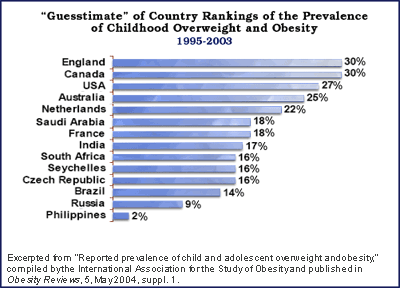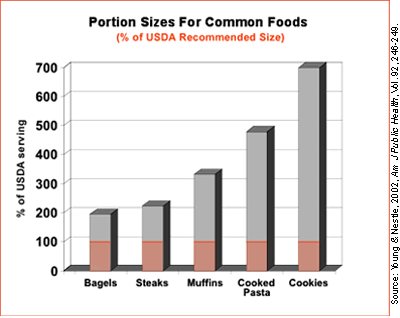
Is There Any Hope of Preventing Childhood Obesity?
by Kelly D. Brownell, Ph.D., Professor and Chair of Psychology, Professor of Epidemiology and Public Health, and Director of the Rudd Center for Food Policy and Obesity, Yale University, New Haven, Conn..

Childhood obesity is on the rise. Currently, some 22 million children under the age of 5 are estimated to be overweight worldwide. Rates of childhood obesity over the past 30 years in the United States alone have doubled in children ages 2 to 5 and have tripled in those ages 6 to 11. In fact, for the first time in America’s history, U.S. children are expected to lead shorter lives than their parents.
Countries across the globe are reporting alarming increases in childhood obesity (above chart). Today, there are clinics for treating obese children in China, and in many developing countries, obesity will surpass malnutrition as the chief nutrition crisis. Reaching epidemic levels in some parts of the world, the problem is also driving the development of debilitating and life-threatening conditions — notably chronic heart disease, type-2 diabetes, gall-bladder disease and large-bowel cancers. Boys born in 2000 in the United States, for example, now stand a 30 percent chance of developing diabetes; the equivalent figure for girls is even higher, at 40 percent — and, even then, only if increases in obesity level off.
Understanding the Problem
Many factors have been implicated as causes of childhood obesity, with genetic susceptibility, the failure of parents, and a “toxic” food and activity environment leading the way. Drawing on both science and common sense, a changing environment is the primary cause. Genetics or mass failures in parenting cannot explain why every country in the world is showing increasing obesity, why people moving from less to more obese countries gain weight, and why laboratory animals that do not overeat healthy foods can become grossly obese when given access to a human “junk food” diet.
For starters, profound changes have occurred in living conditions. The marketing of food to children has exploded, with the average American child seeing 10,000 food advertisements (95 percent for unhealthy foods) on television alone. And traditional television advertisements only begin to capture the onslaught children experience through other channels, including product placements in television shows, movies and videogames. At the same time, the public sector cannot, and will not, keep up. At its peak, the U.S. government’s main nutrition education program, 5 A Day, had a $3 million promotion budget; Coca Cola and PepsiCo combined spend $3 billion on advertising. Meanwhile, school budgets depend on the sale of soft drinks, snack foods and calorie-dense foods in the cafeteria. Portion sizes have increased dramatically. Energy-saving devices, reliance on motorized transport and less active play time for children have minimized energy expenditure. If one were designing societies to maximize obesity, it would be difficult to create more favorable conditions than those seen in countries like the United States.
Changing portion sizes and the time children spend in passive forms of entertainment are prime examples of the toxic environment buffeting today’s youth. One need only look to specific foods like soft drinks: What began in 6.5 ounce bottles is now served in 20 ounce and even 24 ounce plastic containers. (The graph below shows how typical portions of common foods compare to what the U.S. Department of Agriculture considers one serving.) Meanwhile, children have become increasingly passive. Today’s entertainment and play tether children to televisions, computer screens, videogames and headphones. Adding together all forms of media use, the typical American child spends 5.5 hours a day watching, listening and being still.

Addressing the Situation
There are compelling reasons to address obesity by focusing first on children. Obesity is difficult and expensive to treat, making prevention a priority. Childhood is when food preferences and eating habits are learned and hence offers the greatest opportunity for change — a serious issue when you consider that a quarter of all vegetables eaten in the United States are french fries! Finally, most societies consider it important to protect children and therefore may be willing to take action.
To create real change will require real change. Physical activity must be restored as part of everyday childhood, for example, by building and changing communities to promote activity, modifying school curricula to add back physical education, and launching massive campaigns to discourage passive entertainment. Limiting food advertising directed at children, encouraging schools to become healthy nutrition environments, and undertaking major educational and public relations initiatives that promote healthy foods and discourage consumption of unhealthy ones top the list of food-related changes.
Some headway has been made worldwide in identifying prevention strategies. On May 22, 2004, for example, the World Health Assembly endorsed a World Health Organization (WHO) initiative, “Global Strategy on Diet, Physical Activity, and Health,” which contains a blueprint for the promotion of healthier lifestyles to combat the rapid rise in children’s weight. The strategy recommends greater public awareness of the risk factors associated with obesity; exclusive breastfeeding for six months; and healthy diet and physical activity at school and at home. It also purports that growth standards for pre-school children should encourage the adoption of healthy behaviors; governments, consumers and the private sector should ensure that food advertisements and marketing do not exploit children’s credulity; and food aid should encourage the purchase and distribution of nutritious foods.
On a national level, in 2004 the Food and Nutrition Board of the Institute of Medicine issued a congressionally mandated report with an action plan aimed at curbing the rapid rise of obesity in the United States. The report, Preventing Childhood Obesity: Health in the Balance, declared prevention of obesity in children and youth a national priority, and urged the formation of a high-level obesity task force to address this challenge. It suggested a multifactorial approach, with anti-obesity programs aimed at government, schools, industry, the media and parents. The report’s other recommendations, some of which mirror the WHO directive, include: regular monitoring and better evaluation of children’s body weights, and guidance on preventing overweight; community areas that allow children to play safely; national nutrition standards for foodstuffs sold in public schools; guidelines for the advertising and marketing of foods and drinks to children; products that encourage physical exercise among the leisure, entertainment and recreation industries; parental limiting of children’s TV viewing to less than two hours per day; and breastfeeding for the first four to six months of life.
Attempts to curb childhood obesity are also being made on more local fronts. In Berkeley, Calif., famed chef Alice Waters initiated the Edible Schoolyard, a program in which an organic garden on a middle school’s grounds has become the site for learning plant biology, reading poems about nature, harvesting food for the cafeteria and conducting after-school programs. While evaluation remains scant, anecdotal reports indicate very positive impact on the children and their families, and support the belief that healthier diets and increased activity will improve health, well-being and school performance.
But, as children’s weights continue to climb, what is most keenly (and still) needed is a clear recognition of the primary cause of childhood obesity, a commitment to protecting children, and, above all, the determination to avoid a key trap set by the tobacco industry when it stalled aggressive public health actions by framing smoking as a matter of personal choice and individual responsibility. Today’s script is eerily the same, substituting food for tobacco in the language. And the world’s children cannot afford — and certainly do not deserve — a repeat of the tobacco experience.
For more information, contact:
Kelly D. Brownell, Ph.D.
Department of Psychology, Yale University
2 Hillhouse Avenue, Box 208205
New Haven, CT 06520-8205
kelly.brownell@yale.edu